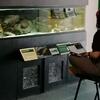One of the rarest cats in the world has been born at the Royal Zoological Society of Scotland’s Highland Wildlife Park, but you won’t be able to see it.
Highland Wildlife Park is home to the zoo world’s only purpose-built Amur leopard habitat which is not on public view. This habitat is designed to breed Amur leopards with minimal human contact so that any cubs could be released into the wild. This would be the first ever reintroduction of a Critically Endangered Amur leopard.
Douglas Richardson, Head of Living Collections at the park, said: “Being able to send captive-bred Amur leopards back to a part of their historic wild range in Russia would represent an extraordinary conservation success.”
Although progress has been made in recent years, habitat loss, poaching for fur and the traditional medicine trade remain threats, with less than 100 Amur leopards left in the wild. By working with conservation partners, including the Zoological Society of London and authorities in Russia, Highland Wildlife Park are hoping to re-introduce leopards to a region northeast of Vladivostok, in the Russian Far East.
Mr Richardson explained: “A phased approach would be needed, with young leopards spending several months acclimatising and sharpening their survival skills in a contained, naturalistic environment within the proposed location of Lazovsky Zapovednik, before being released and monitored.
“This is incredibly exciting and again demonstrates the vital role zoos and conservation breeding programmes have in protecting threatened species.”
With minimal human contact, it is not yet known if more than one cub has been born.
“Initially we confirmed the birth by observing the behaviour of the mother, as Arina had become increasingly secretive,” said Mr Richardson. “We have since heard cub vocalisations and one of our keepers caught a fleeting glimpse of Arina moving a cub from a distance.”
The park’s breeding complex was completed last year; funded by an anonymous donation. This is the first time Freddo (from Tallinn Zoo in Estonia) and Arina (from Twycross Zoo) have bred. Any new cubs add to the very limited population and bring hope for the future of this Critically Endangered big cat.
Related Members
-
NewsZSL leads Earth Day lessons for schoolchildren at 10 Downing Street 24th April, 2024Today, to mark Earth Day 2024, pupils from Greater Manchester, South Wales and London schools had the unique experience of stepping inside 10 Downing…
-
News
 Blog: Working for animal welfare really is worth the effort 24th April, 2024Evidence-based animal welfare needn’t be overwhelming writes Katie McDonald, Deana Stephens, and Paul Rose, members of BIAZA’s Animal Welfare…
Blog: Working for animal welfare really is worth the effort 24th April, 2024Evidence-based animal welfare needn’t be overwhelming writes Katie McDonald, Deana Stephens, and Paul Rose, members of BIAZA’s Animal Welfare… -
NewsBlog: Putting National Parks at the heart of nature recovery 19th April, 2024How much do National Parks contribute to conservation? Ruth Bradshaw (Campaign for National Parks) shares findings: 2024 marks the 75th anniversary of…


